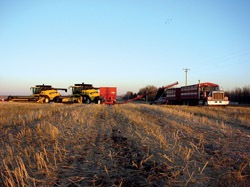
Features
Desiccants
Seed & Chemical
Seed germination hurt with pre-harvest and desiccation applications
If a grower used glyphosate preharvest or a Reglone desiccation in 2009 and the thought is to hold back bin-run (brown bag) seed for 2010, think again, or at the very least, have a germination and vigour test conducted.
March 1, 2010 By Bruce Barker
If a grower used glyphosate preharvest or a Reglone desiccation in 2009 and the thought is to hold back bin-run (brown bag) seed for 2010, think again, or at the very least, have a germination and vigour test conducted.

|
|
| Glyphosate residue causes pea seed to develop with very blunt, short, thickened, brittle primary roots. Photos courtesy of 20/20 Seed Labs | |
 |
|
| Glyphosate residue retest in soil with normal seedling on the right-hand side and abnormal injured seedlings on the left. |
This is especially true for pulse crops. “The residue in seed that we test varies from year to year, but this year definitely has some issues with both glyphosate and Reglone in pulses, and cereals as well,” says Sarah Foster, president of 20/20 Seed Labs at Nisku, Alberta. “We first saw the issues 15 years ago, and did a lot of publicity around it, but it keeps coming back from time to time.”
Glyphosate is not registered for a pre-harvest application for seed crops and pulse crops are particularly susceptible. Glyphosate residue in pea seed can result in reduced germination and increased seedling mortality. Peas that display symptoms of glyphosate damage have very blunt, short, thickened, brittle primary roots and no secondary roots.
Reglone, on the other hand, is registered as a desiccant in seed crops, including pulses, potatoes and sunflower. Reglone residue in pea seed produces similar symptoms as glyphosate residue, with the very subtle difference of having very short secondary roots.
Foster says that the 2009 harvest conditions are most likely the reason for the germination problems found in the harvested seed. The damage seems to be dependant on crop maturity, and timing of application. With uneven ripening of the crop, green patches may have been present when pre-harvest applications were used, resulting in higher-than-normal herbicide residues in the seed.
Foster says that although the seed samples tested in the fall of 2009 were just making the certified seed grade of 80 percent germination for peas and 85 percent germination for cereals, the evidence of herbicide residue in the seed is still cause for concern as the germination can drop over time, showing that they may not always be the most stable seed lots. “My rule of thumb is that if there is more than five percent abnormal germination, you will start to see a decline in germination by February or March. You should think of retesting at that time, and need to keep in the back of your mind that you may need to source new seed,” explains Foster. She says it is not uncommon to see those pulse seed lots drop from 85 percent germination to 15 percent germination during the winter months.
If glyphosate-damaged peas are planted in soil, the epicotyl (the embryonic shoot above the cotyledons) may continue to develop and most times will emerge through the soil. However, the seedling is slower to develop than a healthy seedling, and if the epicotyl was pulled on, the seedling would easily come out of the soil because there is nothing to root or anchor it there. “The vigour is definitely affected. The crop may look okay, perhaps a little set back, but when you pull out the plant, the root is really small,” says Foster.
Nodulation of pulse crops can also be affected. Garry Hnatowich, senior research agronomist with Novozymes in Saskatoon, Saskatchewan, says the point of infection for rhizobium bacteria during nodulation is via a root hair. He explains that during the initial infection, the tip of the root hair bends and the bacteria penetrate the root hair on the inside junction of this bend. A number of physiological and morphological changes occur but for all intents and purposes, the root hair curls around this infection point and the net effect is the development of a nodule. “If glyphosate-damaged seedlings result in fewer, if any root hair development, the point of infection is now removed from the nitrogen fixation system. No symbiotic relationship can develop when the bacteria are effectively locked out,” says Hnatowich. “Consequently no matter how well, how much, or what form of inoculant was applied with the seed, an inoculant failure will occur. It’s a no-win situation from the start.”
The lesson learned from the 2009 seed crop is that if a preharvest glyphosate or Reglone desiccation was used, the seed lots should definitely be tested for germination abnormalities.
And with the late harvest in many areas, frost damage may also be a concern, so even if preharvest or desiccation herbicides were not used, it is still a good idea to test those seed lots before spring.